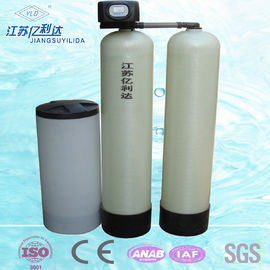Fleck Control Valves Water Softening Equipment For Calcium Magnesium Exchange
Introduction:
Metered water softeners or demand water softeners, count down the set capacity of the softener in
gallons. A softener with a meter initiated control will only regenerate when required as determined by
the volume of water softened.
With a mechanical metered water softener system, homeowners can save both water and salt by
regenerating the on demand softener only when required as compared with time clock initiated controls.
Hard water is not considered unhealthy, but hard water problems end up costing you money through
increased soap usage, build up of calcium scale in your pipes, and shortening the life of your appliances.
The ion exchange water softener is one of the most common tools of water treatment. Its function is to
remove scale-forming calcium and magnesium ions from hard water. In many cases soluble iron (ferrous) can also be
removed with softeners. A standard water softener has four major components: a resin tank, resin, a
brine tank and a valve or controller.
The softener resin tank contains the treated ion exchange resin - small beads of polystyrene. The resin
beads initially adsorb sodium ions during regeneration. The resin has a greater affinity for multi-valent ions such as calcium and magnesium than it does for sodium. Thus, when the hard water
containing the Calcium and Magnesium Ions is passed through the resin bed, the calcium and magnesium
ions adhere to the resin, releasing the sodium ions until equilibrium is reached. The water softener has
exchanged its sodium ions for the calcium and magnesium ions in the water.
Regeneration is achieved by passing a NaCl solution through the resin, exchanging the hardness ions for
sodium ions. The resin’s affinity for the hardness ions is overcome by using a highly concentrated solution
of brine. The regeneration process can be repeated indefinitely without damaging the resin.
Specifications:
|
Category
|
Model
|
Recommended water yield
(M³/h)
|
Tank size
Diameter *Height(mm)
|
Salt box
(L)
|
Amount of resin(KG)
|
|
Single-valve and single-tank
|
YL-I-0.5
|
0.5
|
200×900
|
25
|
20
|
|
YL-I-1
|
1
|
250×1400
|
60
|
40
|
|
YL-I-2
|
2
|
300×1400
|
200
|
60
|
|
YL-I-3
|
3
|
350×1400
|
100
|
80
|
|
YL-I-4
|
4
|
400×1650
|
200
|
120
|
|
YL-I-5
|
5
|
500×1750
|
300
|
180
|
|
YL-I-6
|
6
|
300×1900
|
350
|
240
|
|
YL-I-10
|
8-10
|
750×1900
|
500
|
360
|
|
YL-I-18
|
42-18
|
900×1900
|
800
|
520
|
|
YL-I-25
|
18-25
|
1000×2200
|
1000
|
720
|
|
YL-I-35
|
25-30
|
1200×2400
|
1500
|
1000
|
|
YL-I-50
|
35-50
|
1500×2500
|
2000
|
6400
|
|
Dual-valve and dual-tank (simultaneous operation and respective regeneration)
|
YL-II-36
|
24-36
|
900×1900
|
800
|
1040
|
|
YL-II-50
|
36-50
|
1000×2200
|
1000
|
1440
|
|
YL-II-70
|
50-70
|
1200×2400
|
1500
|
2000
|
|
YL-II-100
|
70-100
|
1500×2500
|
2000
|
3200
|
|
Dual-valve and dual-tank(One for use and the other for standby)
|
YL-II-1
|
1
|
250×1400
|
60
|
80
|
|
YL-II-2
|
2
|
300×1400
|
100
|
120
|
|
YL-II-3
|
3
|
350×1400
|
100
|
160
|
|
YL-II-4
|
4
|
400×1650
|
200
|
240
|
|
YL-II-5
|
5
|
500×1750
|
300
|
360
|
|
YL-II-6
|
6
|
600×1900
|
350
|
480
|
|
YL-II-10
|
8-10
|
750×1900
|
500
|
720
|
|
YL-II-18
|
12-18
|
900×1900
|
800
|
1040
|
|
YL-II-25
|
18-25
|
1000×2200
|
1000
|
1440
|
|
YL-II-35
|
25-35
|
1200×2400
|
1500
|
2000
|
|
YL-II-50
|
35-50
|
1500×2500
|
2000
|
3200
|
Working principle
To absorb the calcium and magnesium ions in the water with resin. As the hardness of the water is mainly formed and expressed by calcium and magnesium, the cation exchange resin (water softener)is generally used to replaceCa2 + and Mg2in the water The resin efficiency to removeca2 + and Mg2+ gradually reduces as ca2 + and Mg2 + in the resin increase. When the resin absorbs a certain amount of calcium and magnesium ions, it is necessary to be regenerated. In the regeneration process, the resin bed is flushed by saline in the salt box and hardness ions on the resin are replaced and discharged with recycled waste fluid, the resin’s function of softening exchange is recovered. The principle of sodium ion exchanging softening treatment is to use sodium cation exchange resin to exchange the hardness ingredients, Ca2 + and Mg2 +, in the raw water with Na + in the resin, absorbing Ca2 + and Mg2 + in the water, so that water gets softened.

Applications:
System automatic water softener widely used in steam bioler,heating bioler,exchanger,air conditioner,
and other systems water softener,also used in hotel,restruant,office, and other life water treatment and
food,drinking,wine,washing,textile,chemical,medicine and other industrial softener water treatment.
Technical parameters
|
Hardness of
raw water
|
≤8mmol/L
|
Power supply
|
220V/50HZ
|
|
Hardness of effluent
|
≤0.03mmol/L
|
Control mode
|
flow rate type, time type
|
|
Inlet water pressure
|
0.2~0.4Mpa
|
Resin
|
001×7 strong acidic cation-exchange
|
|
Free chlorine
|
≤0.3mg/L
|
Working ambient temperature
|
5-50℃
|
|
Suspended solid
|
<0.5mg/L
|
System water temperature
|
5-45℃
|
|
Iron content
|
<0.3mg/L
|
Relative humidity
|
≤95%(25℃)
|


 Your message must be between 20-3,000 characters!
Your message must be between 20-3,000 characters! Please check your E-mail!
Please check your E-mail!  Your message must be between 20-3,000 characters!
Your message must be between 20-3,000 characters! Please check your E-mail!
Please check your E-mail! 




